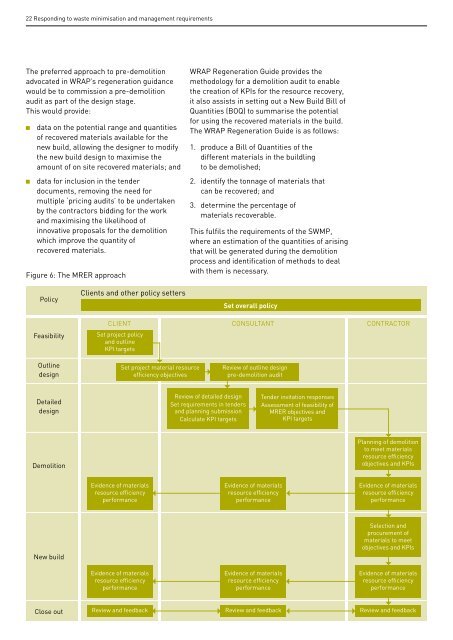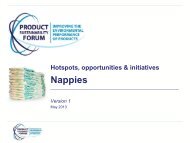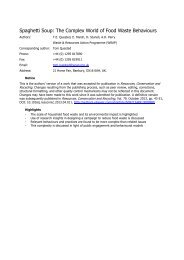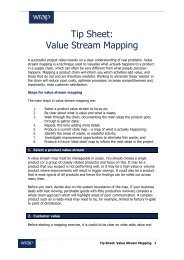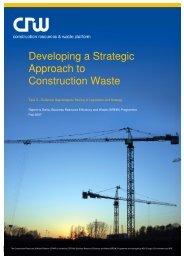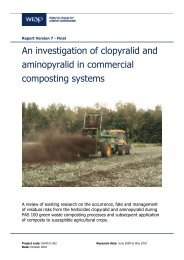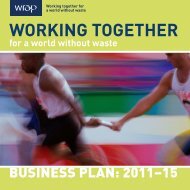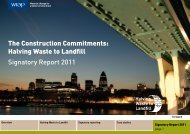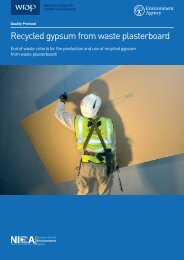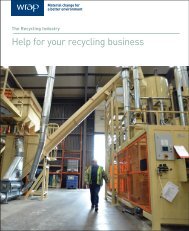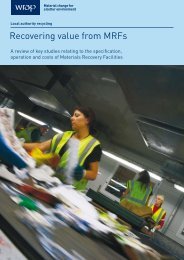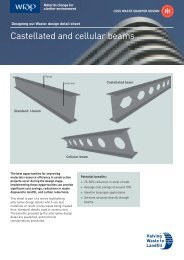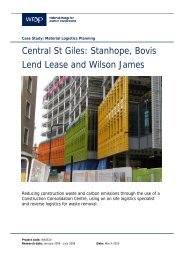Responding to waste minimisation and management ... - Wrap
Responding to waste minimisation and management ... - Wrap
Responding to waste minimisation and management ... - Wrap
You also want an ePaper? Increase the reach of your titles
YUMPU automatically turns print PDFs into web optimized ePapers that Google loves.
22 <strong>Responding</strong> <strong>to</strong> <strong>waste</strong> <strong>minimisation</strong> <strong>and</strong> <strong>management</strong> requirements <strong>Responding</strong> <strong>to</strong> <strong>waste</strong> <strong>minimisation</strong> <strong>and</strong> <strong>management</strong> requirements 23<br />
The preferred approach <strong>to</strong> pre-demolition<br />
advocated in WRAP’s regeneration guidance<br />
would be <strong>to</strong> commission a pre-demolition<br />
audit as part of the design stage.<br />
This would provide:<br />
data on the potential range <strong>and</strong> quantities<br />
of recovered materials available for the<br />
new build, allowing the designer <strong>to</strong> modify<br />
the new build design <strong>to</strong> maximise the<br />
amount of on site recovered materials; <strong>and</strong><br />
data for inclusion in the tender<br />
documents, removing the need for<br />
multiple ‘pricing audits’ <strong>to</strong> be undertaken<br />
by the contrac<strong>to</strong>rs bidding for the work<br />
<strong>and</strong> maximising the likelihood of<br />
innovative proposals for the demolition<br />
which improve the quantity of<br />
recovered materials.<br />
Figure 6: The MRER approach<br />
Policy<br />
Feasibility<br />
Clients <strong>and</strong> other policy setters<br />
WRAP Regeneration Guide provides the<br />
methodology for a demolition audit <strong>to</strong> enable<br />
the creation of KPIs for the resource recovery,<br />
it also assists in setting out a New Build Bill of<br />
Quantities (BOQ) <strong>to</strong> summarise the potential<br />
for using the recovered materials in the build.<br />
The WRAP Regeneration Guide is as follows:<br />
1. produce a Bill of Quantities of the<br />
different materials in the buildling<br />
<strong>to</strong> be demolished;<br />
2. identify the <strong>to</strong>nnage of materials that<br />
can be recovered; <strong>and</strong><br />
3. determine the percentage of<br />
materials recoverable.<br />
This fulfils the requirements of the SWMP,<br />
where an estimation of the quantities of arising<br />
that will be generated during the demolition<br />
process <strong>and</strong> identification of methods <strong>to</strong> deal<br />
with them is necessary.<br />
Set overall policy<br />
client consultant contrac<strong>to</strong>r<br />
Set project policy<br />
<strong>and</strong> outline<br />
KPI targets<br />
Construction companies must ask four<br />
questions at the strip-out stage <strong>and</strong> the table<br />
below identifies the department(s) which<br />
should be responsible for acting upon these<br />
questions <strong>and</strong> the related actions.<br />
Provisions must be made <strong>to</strong> find uses for<br />
resources recovered from the strip-out,<br />
particularly those which can be reused.<br />
A good start is <strong>to</strong> contact local resource<br />
recovery charities <strong>and</strong> publicise excess<br />
material <strong>and</strong> equipment on <strong>waste</strong> exchange<br />
data-bases, 5 particularly when they cannot be<br />
reused on site or on other company projects.<br />
These websites provide information on<br />
companies or organisations that could use<br />
the equipment either in the locality or<br />
further afield.<br />
2.3 Key Performance Indica<strong>to</strong>rs<br />
There are two Key Performance Indica<strong>to</strong>rs<br />
(KPIs) which should be used <strong>to</strong> drive forward<br />
the recovery <strong>and</strong> reuse of demolition <strong>and</strong><br />
construction <strong>waste</strong> material on a project.<br />
These include:<br />
the Demolition Recovery Index (DRI)<br />
– describes the efficiency of material<br />
recovery from demolition calculated as the<br />
quantity of materials recovered from the<br />
demolition process, divided by the <strong>to</strong>tal<br />
quantity of materials generated by it.<br />
the Retained Material (RM) KPI<br />
– a measure of the extent of reuse of<br />
demolition materials on site, calculated<br />
as the quantity of recovered materials<br />
generated from the demolition phase<br />
that are used in the new build, divided by<br />
the <strong>to</strong>tal quantity of recovered materials<br />
created from the demolition.<br />
THINGS TO CONSIDER<br />
Ensure comprehensive underst<strong>and</strong>ing of the principles of<br />
WRAP’s Efficient Use of Materials in Regeneration.<br />
Contrac<strong>to</strong>r should bring the <strong>waste</strong> <strong>management</strong> <strong>and</strong><br />
demolition contrac<strong>to</strong>r on-board immediately.<br />
Design team should be made aware of the data from the<br />
demolition/new build audits <strong>to</strong> incorporate demolition<br />
material in<strong>to</strong> new build design.<br />
Ensure procurement team is aware of demolition materials<br />
available <strong>and</strong> responds accordingly.<br />
Outline<br />
design<br />
Detailed<br />
design<br />
Demolition<br />
New build<br />
Evidence of materials<br />
resource efficiency<br />
performance<br />
Set project material resource<br />
efficiency objectives<br />
Review of detailed design<br />
Set requirements in tenders<br />
<strong>and</strong> planning submission<br />
Calculate KPI targets<br />
Review of outline design<br />
pre-demolition audit<br />
Evidence of materials<br />
resource efficiency<br />
performance<br />
Tender invitation responses<br />
Assessment of feasibility of<br />
MRER objectives <strong>and</strong><br />
KPI targets<br />
Planning of demolition<br />
<strong>to</strong> meet materials<br />
resource efficiency<br />
objectives <strong>and</strong> KPIs<br />
Evidence of materials<br />
resource efficiency<br />
performance<br />
Selection <strong>and</strong><br />
procurement of<br />
materials <strong>to</strong> meet<br />
objectives <strong>and</strong> KPIs<br />
Question<br />
1. Can the materials be<br />
recycled or reused within<br />
the new build<br />
2. Can materials be<br />
reused elsewhere within<br />
the company<br />
Who should be involved<br />
Design team Procurement team Site team<br />
The design team should<br />
follow the ICE Demolition<br />
Pro<strong>to</strong>col <strong>and</strong> WRAP’s<br />
Efficient Use of Materials<br />
in Regeneration guide. 6<br />
Table 3: Structuring the materials recovery process<br />
The procurement team<br />
should be responsible for<br />
finding out where these<br />
materials might be needed<br />
in the company <strong>and</strong> whether<br />
it would be economically<br />
viable <strong>to</strong> deliver them <strong>to</strong> the<br />
specified site.<br />
The site team should utilise<br />
the expertise <strong>and</strong> knowledge<br />
of the <strong>waste</strong> <strong>management</strong><br />
contrac<strong>to</strong>r.<br />
Close out<br />
Evidence of materials<br />
resource efficiency<br />
performance<br />
Evidence of materials<br />
resource efficiency<br />
performance<br />
Evidence of materials<br />
resource efficiency<br />
performance<br />
Review <strong>and</strong> feedback Review <strong>and</strong> feedback Review <strong>and</strong> feedback<br />
5. See Table 7: Materials Exchange Websites<br />
6. WRAP’s Efficient Use of Materials in Regeneration guide is a step-by-step guide linking the Demolition Pro<strong>to</strong>col through <strong>to</strong> the<br />
initiation of a SWMP


